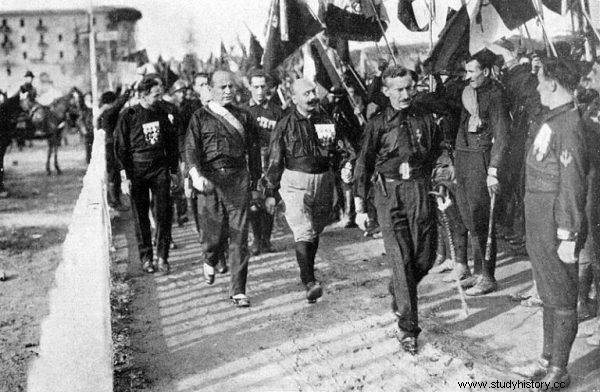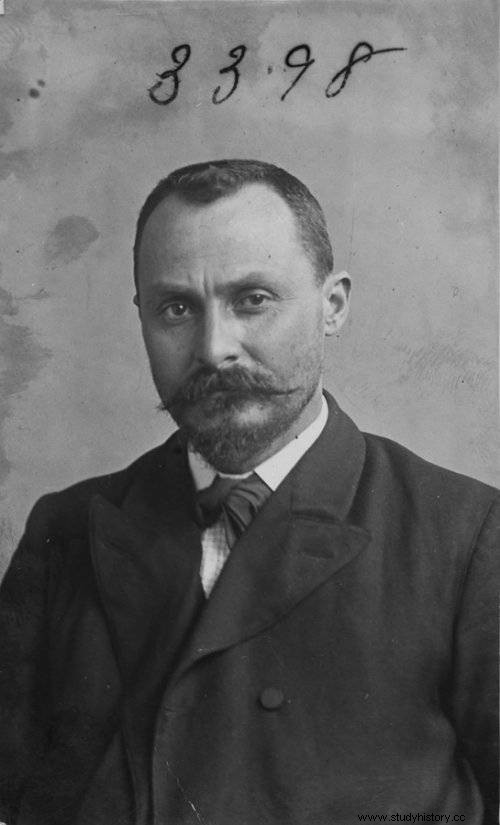The Italian mafia can be compared to the mythological hydra. When her head is cut off, she breeds two more in its place and becomes even stronger. However, one man almost managed to smash the criminal structures that ruled the south of the country and lock up the major Sicilian mafiosi in prisons.
Organized crime in the Apennine Peninsula has been associated with the world of politics and the economy for decades. Like a cancer, it consumes Italian society. All this makes it almost impossible to fight the mafia effectively.
The world of organized crime abhors a vacuum, and whenever it seems that the final defeat of the mafia is imminent, it is reborn. However, in the 1920s and 1930s, the Italian state was practically a haircut away from eradicating the mafia plague. The main initiator and coordinator of the action of destroying criminal structures was the former policeman and prefect of Palermo, Cesare Mori, also known as the "iron prefect" - "il profeto di ferro". It all started with Benito Mussolini's hurt pride.
Duce, Sicily and the Fascists
The year is 1924. Two years have passed since Mussolini organized the famous "March to Rome" and fascism has spread throughout Italy. Whole? Not. There is one large island in the south where a handful of brave mafiosi resist Rome and are reluctant to watch what Mussolini is doing in the rest of the country.
After a short flirtation with the fascists, criminals operating in Sicily finally decide not to enter into close cooperation with Mussolini and with the assumption that no one is interfering with their interests, they want to remain relatively neutral. This peculiar state of equilibrium is breaking down, however.

Mussolini took power as a result of the so-called March on Rome
Many historians confirm that the Duce himself is responsible for this turn of events, namely the insult he suffered during one of his farm visits to Sicily. In May 1924, during a tour around the town of Piana dei Greci, the accompanying mayor of the city and longtime mafioso Don Ciccio Cucci showed great surprise at the numerous police escorts that surrounded Mussolini. He would then say to him:"But your Excellency, by my side you have nothing to fear, because here in the whole neighborhood I am ordering you." This remark cruelly angered Mussolini and made him realize how strong the position of the mafia is in southern Italy.
Duce assumes that, for the sake of his political plans, the Sicilian problem must be solved as soon as possible. The person selected by Mussolini to fight the mafia is Cesare Mori. This former policeman and tough, relentless administrator will soon launch one of the greatest anti-mafia operations in Italian history.
A man with a hairy heart
Of course, Mori's success in the fight against the mafia would not have been possible without the full involvement of the fascist state apparatus. It must be admitted, however, that the ruthlessness and ferocity with which he carried out the task entrusted to him are truly admirable.
He was born in Pavia near Milan in 1872. In Italy at the time, the only career that a smart boy without any connections could make was in the army or the police. Mori eventually chose the latter option.
During his service in the police, he was characterized by above-average commitment, determination and firmness. He quickly climbed up in the police hierarchy, and with another promotion in 1904 he was transferred to Sicily. During 13 years of work, he perfectly learned the methods of operation of the mafia and thanks to the knowledge gained in this way, he was soon to become the terror of the criminal underworld.

Cesare Mori, also known as the "Iron Prefect"
Before Mussolini invited him back to Sicily, Mori commanded the police in Turin and Rome and became the prefect of Bologna. Finally, equipped with such extensive experience, in 1924 he was delegated to Trapani, where his main task was to fight Sicilian criminals.
In the war against the mafia
Mori on December 9, 1925, was appointed prefect of Palermo. Initially, he does not pull out the heaviest cannons yet and is trying to prepare the right ground for the planned police actions in the future. As a person who spent several years in Sicily, he knows the mechanisms and methods of operation of the mafia very well. Therefore, his stay in Palermo begins with the introduction of strict rules and regulations. It also urges Sicilians to stop paying racketeering and using mafia "protection".
The prefect gives a clear signal to the Italian society that law and order are returning to Sicily and that the citizens are not left unattended by the state. Once the paperwork is over, Mori goes into action and embarks on an unprecedented and massive police action.
Deeply conspiratorial units under his leadership work out criminal networks in a given area, and then carry out manhunts and mass arrests. They do it in a truly Hollywood style. An example is the January 1926 siege of the city of Gangi - at night more than fifty policemen surrounded the city with a cordon. Armored trucks blocked the roads, and carabinieri manned every surrounding elevation and vantage point.
Criminals living in Ganga were cornered and panicked for places where they could hide or barricade . As police forces entered the city, massive house searches and arrests began. The cordon was held for the following days. Some of the less resilient mafiosi gave up, but many criminals - like rats - continued to sit buried in their hideouts.
However, Mori's troops were patient. The policemen confiscated and destroyed the property of the bandits. Their cattle were slaughtered and sold to local residents for a fraction of the price, and mafiosi's homes were inhabited by officers who often did not shy away from raping their wives. Women and children became hostages, and previously captured criminals were brutally interrogated. When the city finally fell, a total of 130 members of Cosa Nostra and over 300 of their associates were arrested. The result is more than satisfactory.
Iron Prefect
The resolute, if not brutal, pacification of Ganga shows how determined Mori was to crack down on the Sicilian mafia. There will be dozens more in the next few years of police action, such as the one at Gangi. Some more, some less successful - but all equally firm.
The brutality of the measures used by Mori was, in a way, inherent in the police and totalitarian state that the Duce had created, and the prefect was often much more ruthless than the mafia itself. Propaganda was also an important aspect of Mori's policy. Taking control of the press and consistently building anti-mafia rhetoric has become as important as police pacification actions. On the other hand, Mori also tried to build an image of himself as a defender of society and persuade Sicilians to stand up to criminals.

Don Vito Cascio Ferra,
By 1929, eleven thousand people were arrested, and mafia trials were carried out at an express pace. Sometimes the judiciary acted too quickly, leading to unjustified sentences and convictions of innocents, but that was a price Mori was willing to pay without hesitation.
Slowly, in the collective consciousness of the inhabitants of Sicily, the image of the "iron prefect", the mafia slayer, began to form. Mori himself, a well-built man with angular features and a deep timbre of voice, also did everything to make the mafiosi fear him. As he crushed the criminal empire of Don Vita Cascio Ferry, one of the greatest Sicilian mafiosi, he came to a city he controlled and gave a speech there, starting with the sentence:"My name is Mori and I bring death."
Pyrrhic victory
Unexpectedly, in mid-1929, Mori receives a telegram from Mussolini in which the latter… thanks him for his work and sends him into retirement. For Duce, the most important was the propaganda effect of Mori's actions.
When the press officially announced that the campaign against the mafia is over, the prefect of Palermo is no longer needed. Mussolini is already probably in power by then and Cosa Nostra is not a big problem for him. He does not care that many years of systematic work are still needed to completely oust the criminals from Sicily and secure the island from their return.
Mori dies in oblivion in 1942, and the Allies land in Italy in 1943. Old criminal arrangements are reborn under the American administration, and the mafia, liberated from fascism, is slowly beginning to recover.

Power structure of the mafia clan
Although Mori ultimately failed to completely smash Cosa Nostra, his actions burned a deep scar in the mafia's tissue. It was during his time that many mafiosi had to seek help in exile and flee abroad (including to the United States). When, over forty years later, Giovani Falcone, another great mafia conqueror, interrogates the repentant mafia of Catania, Antonio Calderone, who says about Mori's rule:
[During the fascist period] the melody changed completely. Many suddenly found themselves imprisoned on a guarded island. It was brought about by Mussolini, Mori and others responsible for the administration of justice (…). After this war, the mafia almost ceased to exist. Sicilian families have been broken up.
In early January this year, the largest trial against the Italian mafia in years began in the city of Lamezia Terme in Calabria. 325 members of the Calabrian 'Ndrànghetta were brought to trial, charged with a wide variety of crimes.
This shows that the mafia in Italy is still a powerful force. However, you can ask yourself a rhetorical question and wonder what would happen if Duce let Mory work for another ten years? Would the history of the Italian Mafia be different today? Would the activities of Cosa Nostra, Gomorra and 'Ndrànghetta have any raison d'être today and would it be possible to avoid hundreds of thousands of victims of mafia reckoning? Unfortunately, we will never know that again.
